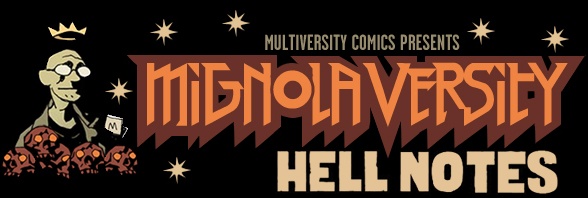
Twenty years ago today, Hellboy made his debut appearance in a four-page, black-and-white story in San Diego Comic-Con Comics #2, distributed at the 1993 San Diego Comic-Con. He wouldn’t get his own miniseries until March the following year, but the 19th of August, 1993 is where everything began. Jump forward twenty years and there are four Hellboy-related comics coming out in this month alone.
Today we not only celebrate the birth of a character, but of an entire universe. Though everyone’s been busy with Artist August, the Mignolaversity team has still found time to put together a few things I’m sure you’ll enjoy, so be sure to check back in later today. But for now, let’s kick this thing off!

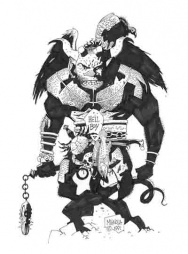
An idea rarely arrives fully formed, and Hellboy was no different. Mike Mignola’s attributed the genesis of the character to a picture drawn for a convention program book. The similarities between this first version of the character and his final form are largely superficial, save one detail; the name “Hell Boy” written on the character’s belt written at the last minute. Mignola’s reason for keeping the name was simply that it sounded funny, and it was important that the series have some humor about it.
Over time the idea grew, and other characters were added as Mignola explored making a sort of paranormal superhero team book. As you can see in the image below, Hellboy’s final design is starting to emerge. He has his stone right hand, and his shorn-off horns. Also present here are two characters that didn’t make the cut (but would continue percolating in Mignola’s brain to eventually become the basis for Captain Benjamin Daimio and Johann Kraus), plus an early Liz Sherman, and “Dr. Douglass Hogg,” who would later be renamed Abe Sapien. This team worked for the “Sidwell Institute for Paranormal Research and Defense,” a secret organization with its headquarters hidden underneath an old water tower.

As the concept evolved, many of the superhero tropes fell away. The Sidwell Institute became the Bureau for Paranormal Research and Defense, and no longer a secret. Hellboy became smaller, and his shoulders began to droop. His whole design suppressed the heroic aspect, emphasizing instead that he was just a regular working stiff (a trait many of his fans will tell you is a huge part of his appeal).

Oh, and there were plenty of frog monsters and Nazis, of course. That much at least seems to have been there since inception.
Early Days

For the next story, The Wolves of Saint August, the training wheels came off. Originally published in Dark Horse Presents in black and white, this was truly Mignola alone. It’s a great story, and it introduced Dr. Kate Corrigan (My favorite character. Incidentally, she’s modelled off of Mignola’s wife, Christine). There’s a definite shift in the pacing of this story compared to the last, more silent moments with little beats to take in the environment and its history, making it a much more active part of the story. This is an element of storytelling I think of as synonymous with all Mignola’s modern works, and it is a joy to see it evolving so quickly here. Plus Hellboy yells, “BOOM!” as he hits a werewolf.
Continued below
It also introduced many key characters for the series; Gruagach, the changeling, Dagda, High King of the Tuatha De Danann, and Alice Monaghan, who later become Hellboy’s girlfriend. The most significant addition though, was not on the page. Up until this point Barbara Kesel had been Mignola’s editor, but she was departing Dark Horse, so a young Scott Allie was given the job of temporary editor until a real editor could be brought in. Although instructed to only check for spelling mistakes, Allie felt strongly enough to point out that there was a hole that didn’t really look like a hole. It was the first time in fourteen years that someone had asked Mignola to fix anything, and he was so impressed that he went to Mike Richardson (founder of Dark Horse comics) and requested Allie be made his permanent editor. Today, Scott Allie is the Editor in Chief at Dark Horse and handles all Mignola’s various works, including Abe Sapien, of which he is the regular writer.
The next miniseries, Wake the Devil would introduce another key member of the Hellboy team, colorist Dave Stewart, though in these early days he was a color separator for James Sinclair. This would also be Mike Mignola’s first solo multi-issue story, and frankly, it’s great to see him having fun in this one. Just take a look at how easily the page below shifts through various moods without breaking the atmosphere or tension of the story.


“The Middle Period”

Each of these stories is so much fun.
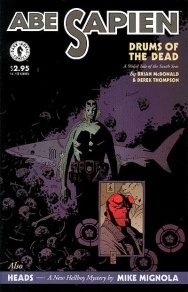
This period also introduced the first Hellboy spin-off, the often forgotten one-shot Abe Sapien: Drums of the Dead by Brian McDonald with art by Derek Thompson. And there was a ten-page story introducing Lobster Johnson, who would play a major role in the next Hellboy miniseries, Conqueror Worm.
Departure

For Hellboy this meant he was free to slip into stories that drifted further from human reality, but for Abe, Liz, Kate, and Roger back at the Bureau, this meant trying to figure out how to tell paranormal investigation stories minus their usual lead. There was no way for Mike Mignola to draw both Hellboy and the new B.P.R.D. series, and he was too busy with the first Hellboy film to be the regular writer, so the search began for a new creative team for the book.
Previously Mignola had handled all the work himself, so finding a way to work with others was somewhat of an experiment at first. Various writers and artists tried their hand with the series at this time in an attempt to see what worked and what didn’t. The B.P.R.D. stories in this period play it fast loose at times, and it really demonstrates all the many different directions the series could have gone.
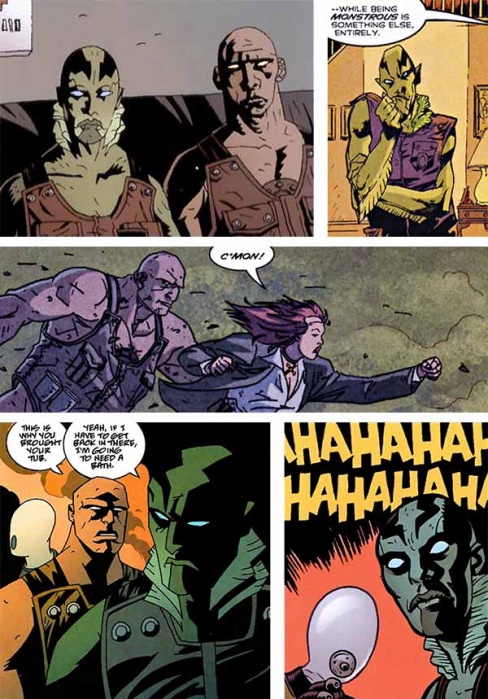

Around this same period of time, the ongoing Hellboy stories were running into difficulties. While Conqueror Worm had a relatively smooth journey to the page, the next miniseries was not taking shape as planned. Originally intended to be a tale in Africa, the story quickly shifted instead to the ocean depths for The Third Wish. Mignola struggled with the cover for the second issue, finally settling on his fourth attempt.
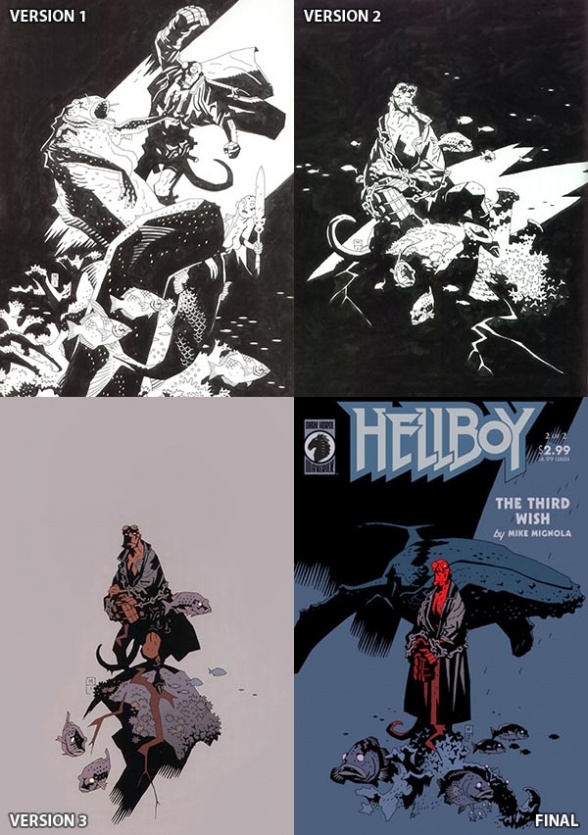
The Island ran into even more problems. Whole pages were completed and then discarded. The story was a one-shot, then three issues, and kept changing back and forth until finally landing in the middle. It was Mignola’s most difficult story to date.
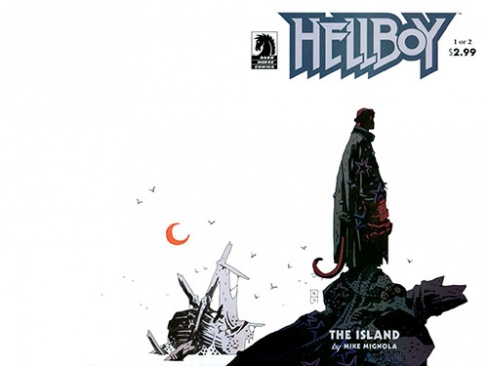
However, the difficulties of The Third Wish and The Island don’t show on the page. They are decidedly more somber pieces, true, but these two stories are stunning pieces of work. The Island in particular is one of the finest comics I’ve had the pleasure to read, and even years later, I am still finding new things in it to appreciate. And all those discarded pages make for one hell of a sketchbook section.
Continued belowEmbracing Change

Once again, we owe Glen Murakami a debt of gratitude. It was he that championed Duncan Fegredo for the job, and what a revelation he was. In retrospect, no one else could possibly have delivered on such an impossible task.

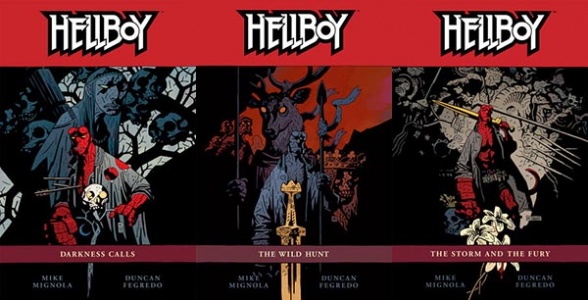


John Arcudi really dug deep with the characters and their relationships with one another, and with this a bunch of morally ambiguous gray areas started to emerge. And Guy Davis brought so much nuance to the performance of his drawings, to layout, and design. During this time, Hellboy was continuing its slower pace, while B.P.R.D. was speeding up. In 2007 B.P.R.D. starting coming out on a monthly basis, and in 2008 a series of miniseries covering the early days of the Bureau with 1946 and 1947 written by Joshua Dysart with Mike Mignola was added to the schedule (This series was originally planned to go on into the 1950s, but it was ultimately cancelled when Mignola became too busy).

The universe began expanding rapidly at this point. A Lobster Johnson spin-off launched, closely followed by Abe Sapien and Witchfinder. These spin-offs shared direct links to characters and plot points in B.P.R.D. and this, combined with the increased output, caused the series to shift into the role of the flagship title for the Hellboy Universe. With the coming of the Scorched Earth trilogy, B.P.R.D. now had more volumes than its parent series. This trilogy was an arc designed to bring a close to twelve volumes of the Plague of Frogs cycle and set the stage for something new to follow…

Mignola had always spoken about the end of the world in his comics, but in the new B.P.R.D. story cycle, Hell on Earth, it finally became a reality. The world was overrun with monsters and constant natural disasters. Liz left the Bureau, Daimio died, Abe got shot up by a psychic teenager… With so many of the core cast incapacitated, the regular human agents stepped to fill the void that was left. But the biggest change for the series came in 2011 at the Emerald City Comic Con.
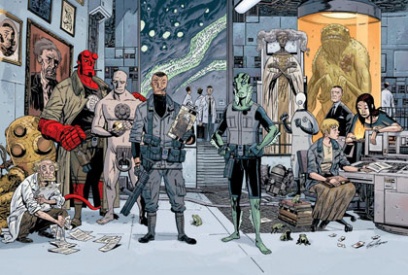
After more than fifty issues on the series, Guy Davis was stepping down as the artist on B.P.R.D.. It came out of nowhere and it left us all stunned. Guy Davis had become so synonymous with B.P.R.D., it really felt like he should always be a part of it. At the very same panel it was announced that newcomer Tyler Crook, fresh off the original graphic novel Petrograd, would be stepping up as the new ongoing artist. However, unlike Guy Davis, he would not be solely responsible for the ongoing story. Other guest artists would now come on board for arcs, creating many shorter arcs, unlike the standard five-issues story arcs in the Plague of Frogs cycle. The Mignolaverse was starting to accumulate a collection of semi-regular artist working on various series.
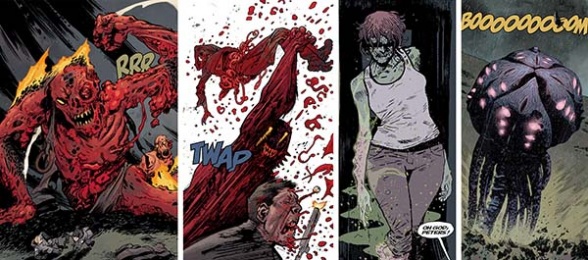
I really feel I have to mention the work of Dave Stewart here. He has colored virtually everything in the Hellboy universe since 1998, and thanks to his efforts, despite all the many artists at work on it now, it still feels unified, even though he changes the way he colors depending on the artist. His mark is on everything, and I couldn’t imagine it without him. It’s no wonder he’s won eight Eisners.

Despite Hellboy being dead and all, there was some good news. Mignola was going to return as the ongoing artist of the series. Set in Hell. Oh, and the series was going to be an ongoing series from now on (though only a handful of issues per year). For its one-hundredth issue, B.P.R.D. also became an ongoing, and shortly after Abe Sapien woke up and got his own ongoing series too.
Which pretty much brings us to the present. So, what’s next?
The Future
This Wednesday B.P.R.D. Hell on Earth #110 comes out, beginning a new five-issue arc, Lake of Fire from John Arcudi and artist Tyler Crook. You won’t want to miss this one, as it features the return of Liz Sherman after a four-year period of sporadic appearances.


October will also see the release of the original graphic novel Hellboy: The Midnight Circus. This book is truly something unique in the Hellboy universe. It’s a story centered on the young Hellboy, something fans have wanted for a long time, but what really makes this special is the art from Duncan Fegredo. This book features the ink-wash technique used on his B.P.R.D. covers from last year, but this time on story pages. If you’ve seen the previews, you know already it is a spectacular thing to behold.
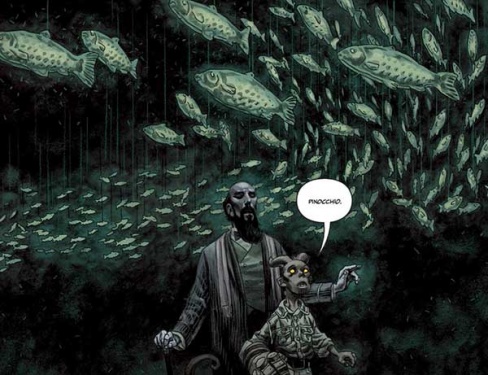
In December Hellboy in Hell #5 hits the shelves, featuring Mignola’s take on a Brothers Grimm tale. Expect more Mignola unfettered from the limitations of the real world, doing what he does best. We’ll have an exclusive first look at it later today. You won’t want to miss it.
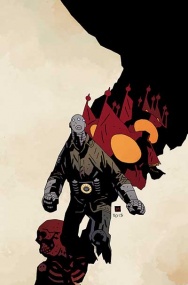
The incredible B.P.R.D.: Vampire recently wrapped up, featuring a story from the twins Fábio Moon and Gabriel Bá, but don’t think for a moment that’s where that story ends. In a recent podcast with Pop Culture Hound Mignola made a point of mentioning that the trade coming out in November will bear a 1 on its spine… There’s certainly more to come, though the twins are busy guys. It might be a long wait.


Beyond that, we have a few tantalizing teases in the sketchbook sections of the trades. In B.P.R.D. Hell on Earth – Volume 6: The Return of the Master, released earlier this month, there were several pages of design work for the new Black Flame by James Harren, a glimpse at what the character will look like in his next story for the series.
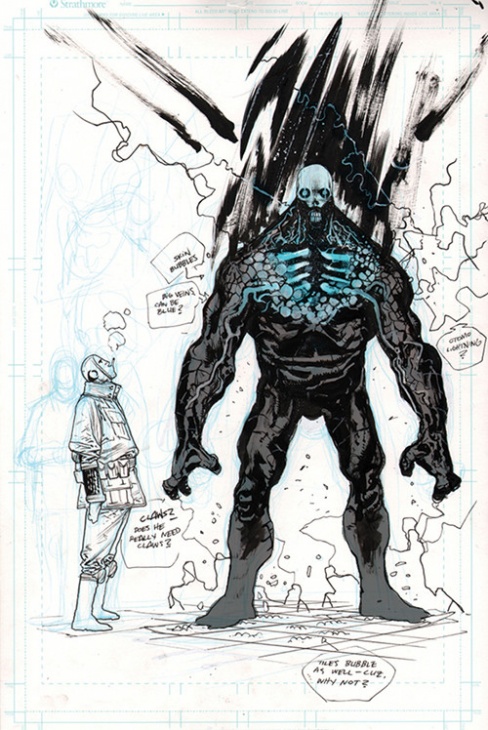
And Mignola has been teasing future Hellboy stories in the Library Editions. Volume 1 hints at a tale about a girl encased in an amber block, Volume 2 shows a bunch of demons we’ll see in the pages of Hellboy in Hell someday, plus a bunch of stony guys that will appear in the comic in a few years, Volume 3 features fungus men that were originally meant for a version of The Island but will now appear in another story… Mignola’s said in interviews he has enough stories kicking around in his head to keep him going for many years, and I believe it. Twenty years this universe has been unfolding and expanding, showing no signs of slowing down. Actually the opposite is true. It’s only August and already this year has released more issues than any before, yet the series remains in top form. It is truly a monumental achievement.
In twenty years we have seen some incredible stuff, but I honestly believe the best is still yet to come. Mike Mignola, you make damn good comics. Cheers!







